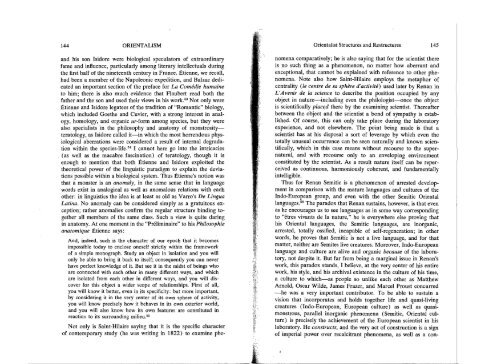Orientalism - autonomous learning
Orientalism - autonomous learning
Orientalism - autonomous learning
Create successful ePaper yourself
Turn your PDF publications into a flip-book with our unique Google optimized e-Paper software.
144 ORIENTALISM<br />
Orientalist Structures and Restructures<br />
145<br />
and his son Isidore were biological speculators of extraordinary<br />
fame and influence, particularly among literary intellectuals during<br />
the first half of the nineteenth century in France. Etienne, we recall,<br />
had been a member of the Napoleonic expedition, and Balzac dedicated<br />
an important section of the preface for La Comedie humaine<br />
to him; there is also much evidence that Flaubert read both the<br />
father and the son and used their views in his work.53 Not only were<br />
Etienne and Isidore legatees of the tradition of "Romantic" biology,<br />
which included Goethe and Cuvier, with a strong interest in analogy,<br />
homology, and organic ur-form among species, but they were<br />
also specialists in the philosophy and anatomy of monstrosityteratology,<br />
as Isidore called it-in which the most horrendous physiological<br />
aberrations were considered a result of internal degradation<br />
within the species-life. 54 1 cannot here go into the intricacies<br />
(as well as the macabre fascination) of teratology, though it is<br />
enough to mention that both Etienne and Isidore exploited the<br />
theoretical power of the linguistic paradigm to explain the deviations<br />
possible within a biological system. Thus Etienne's notion was<br />
that a monster is an anomaly, in the same sense that in language<br />
words exist in analogical as well as anomalous relations with each<br />
other: in linguistics the idea is at least as old as Varro's De Lingua<br />
Latina. No anomaly can be considered simply as a gratuitous exception;<br />
rather anomalies confirm the regular structure binding together<br />
all members of the same class. Such a view is quite daring<br />
in anatomy. At one moment in the "Preliminaire" to his Philosophie<br />
anatomique Etienne says:<br />
And, indeed, such is the character of our epoch that it becomes<br />
impossible today to enclose oneself strictly within the framework<br />
of a simple monograph. Study an object in isolation and you will<br />
only be able to bring it back to itself; consequently you can never<br />
have perfect knowledge of it. But see it in the midst of beings who<br />
are connected with each other in many different ways, and which<br />
are isolated from each other in different ways, a,nd you will discover<br />
for this object a wider scope of relationships. First of all,<br />
you will know it better, even in its specificity: but more important,<br />
by considering it in the very center of its own sphere of activity,<br />
you will know precisely how it behaves in its own exterior world,<br />
and you will also know how its own features are constituted in<br />
reaction to its surrounding milieu. 55<br />
Not only is Saint-Hilaire saying that it is the specific character<br />
of contemporary study (he was writing in 1822) to examine phe-<br />
nomena comparatively; he is also saying that for the scientist there<br />
is no such thing as a phenomenon, no matter how aberrant and<br />
exceptional, that cannot be explained with reference to other phenomena;<br />
Note also how Saint-Hilaire employs the metaphor of<br />
centrality (Ie centre de sa sphere d'activite) used later by Renan in<br />
L'Avenir de la science to describe the position occupied by any<br />
object in nature-including even the philologist-once the object<br />
is scientifically placed there by the examining scientist. Thereafter<br />
between the object and the scientist a bond of sympathy is established.<br />
Of course, this can only take place during the laboratory<br />
experience, and not elsewhere. The point being made is that a<br />
scientist has at his disposal a sort of leverage by which even the<br />
totally unusual occurrence can be seen naturally and known scientifically,<br />
which in this case means without recourse to the supernatural,<br />
and with recourse only to an enveloping environment<br />
constituted by the scientist. As a result nature itself can be reperceived<br />
as continuous, harmoniously coherent, and fundamentally<br />
intelligible.<br />
Thus for Renan Semitic is a phenomenon of arrested development<br />
in comparison with the mature languages and cultures of the<br />
Indo-European group, and even with the other Semitic Oriental<br />
languages. 56 The paradox that Renan sustains, however, is that even<br />
as he encourages us to see languages as in some way corresponding<br />
to "etres vivants de la nature," he is everywhere else proving that<br />
his Oriental languages, the Semitic languages, are inorganic,<br />
arrested, totally ossified, incapable of self-regeneration; in other<br />
words, he proves that Semitic is not a live language, and for that<br />
matter, neither are Semites live creatures. Moreover, Indo-European<br />
language and culture are alive and organic because of the laboratory,<br />
not despite it. But far from being a marginal issue in Renan's<br />
work, this paradox stands, I believe, at the very center of his entire<br />
work, his style, and his archival existence in the culture of his time,<br />
a culture to which-as people so unlike each other as Matthew<br />
Arnold, Oscar Wilde, James Frazer, and Marcel Proust concurred<br />
-he was a very important contributor. To be able to sustain a<br />
vision that incorporates and holds together life and quasi-living<br />
creatures (Indo-European, European culture) as well as quasimonstrous,<br />
parallel inorganic phenomena (Semitic, Oriental culture)<br />
is precisely the achievement of the European scientist in his<br />
laboratory. He constructs, and the very act of construction is a sign<br />
of imperial power over recalcitrant phenomena, as well as a con
















